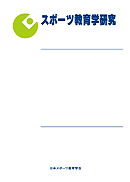All issues

Volume 33 (2013)
- Issue 2 Pages 1-
- Issue 1 Pages 1-
Volume 33, Issue 2
Displaying 1-3 of 3 articles from this issue
- |<
- <
- 1
- >
- >|
-
Yusuke MATSUMOTO, Akiyo MIYAZAKI, Hiromi MIKI, Yoshinori OKADE2013 Volume 33 Issue 2 Pages 1-13
Published: October 31, 2013
Released on J-STAGE: June 11, 2014
JOURNAL FREE ACCESSIn this study, we examined if early-year elementary school children were able to learn selecting appropriate hands movements for catching and if they learned effect to improve the catching performance by learning the selection of appropriate hands movements. The subjects were 245 elementary school 1•2 years. They had a 15-minute practice in the beginning of a PE class. In 10 PE classes out of 20, the children had a practice of catching with hands. In the next 10 classes, they had a practice of selecting overhand catching for a ball coming higher than their breast and underhand catching for a ball coming lower than the breast and locomotion of trunk towards the ball. We evaluated their catching performance with success rate of catching a ball, rate of successful catching a ball with hands among the total of catching trials, success rate of selecting appropriate hands movements and catching pattern. The main findings were as follows.
1) The early-year elementary school children increased the rate of selecting appropriate hands movements through the program. After learning the rate of selecting appropriate hands movements increased higher than 70%.
2) Early in the program, more than half of the children were able to catch with hands, but many of them still caught with inappropriate hands movements in the direction of the ball. However, children were able to determine the selection of appropriate hands movements with the later program of learning the selection of appropriate hands movements, and were able to catch with hands 80% of children.View full abstractDownload PDF (1191K) -
Investigation of Planning Reports for Physical Education Lessons in Practice Teaching by Text Mining— Method of Analyzing for Free Writing Comments —Koichi MOKUSHI , Tetsuji KAKIYAMA , Naota SOGO , Sigeharu IEDA2013 Volume 33 Issue 2 Pages 15-22
Published: October 31, 2013
Released on J-STAGE: June 11, 2014
JOURNAL FREE ACCESSIn practice teaching, a student teacher of physical education has various plans for physical education lessons. Researching their plans helps us for developing the training program of practice teaching. The purpose of this study was to investigate the characteristics of the student teachers’ plans for physical education lessons in the practice teaching by Text Mining method. 317 students (male=194, female=123) were participated in this study. In the subsequent lesson of practice teaching, they were asked about their plans in the form of the open-ended questions. We analyzed their free writing comments. The method of Text Mining was used for the credibility and the convenience in the process of analyzing. The characteristics of their descriptions were evaluated by the number of appearances of words. The words which occurred less than about 5% were excluded. On the other hand, the words whose number of appearances was prominent were also excluded, because these associations with contents were low.Six words which were “fun” (47 times), “explanation” (44 times), “think” (43 times), “use”, “example” and “voice” were extracted. The “fun” and “think” had various co-occurrences. Especially “think” co-occurred with “oneself” and “safe” frequently. The “explanation” co-occurred with “do” and “use”, and “voice” did with “big” and “speak”, respectively. The result of the dependency analysis indicated that “voice + speak”, “care + take”, “voice + big”, “example + show” and “direction + give” occurred more than 6 times. It was suggested that student teachers regarded “fun”, “safe” and “explanation” as important. The “voice” had little relationship with interaction between teachers and students. The method of Text Mining could be used for investigation of planning reports for physical education lessons in practice teaching.View full abstractDownload PDF (532K)
-
A Comparison Between the Written observations of Second and Sixth GradersKazuki OSEDO , Kenji KUBO , Seiichiro KIHARA2013 Volume 33 Issue 2 Pages 23-33
Published: October 31, 2013
Released on J-STAGE: June 11, 2014
JOURNAL FREE ACCESSThis research aims to examine the motion information described by elementary school pupils after watching videos. Second graders and sixth graders of an elementary school were asked to describe in writing the techniques they observed in videos. We then compared the contents of the written observations of the two groups of graders. Subsequently, we discussed the written observations by classifying them into cases; case analysis revealed the following three points.
(1) While e second graders tended to focus on the preparation for a technique, the sixth graders used many nouns signifying parts of the body, such as leg, hand, back, and head, in their written observations.
(2) The sixth graders described the trunk of the body and legs and major phases of a technique. This indicates that the six graders tended to observe the moves essential for a technique.
(3) Some sixth graders described leg movements using a spatial image and timing and time lag between movements. Although some second graders also produced similar descriptions, their descriptions were exceptions. Analysis of the description contents of the second graders revealed that they were not adequately competent to explain the movements of the trunk of the body and legs.View full abstractDownload PDF (858K)
- |<
- <
- 1
- >
- >|